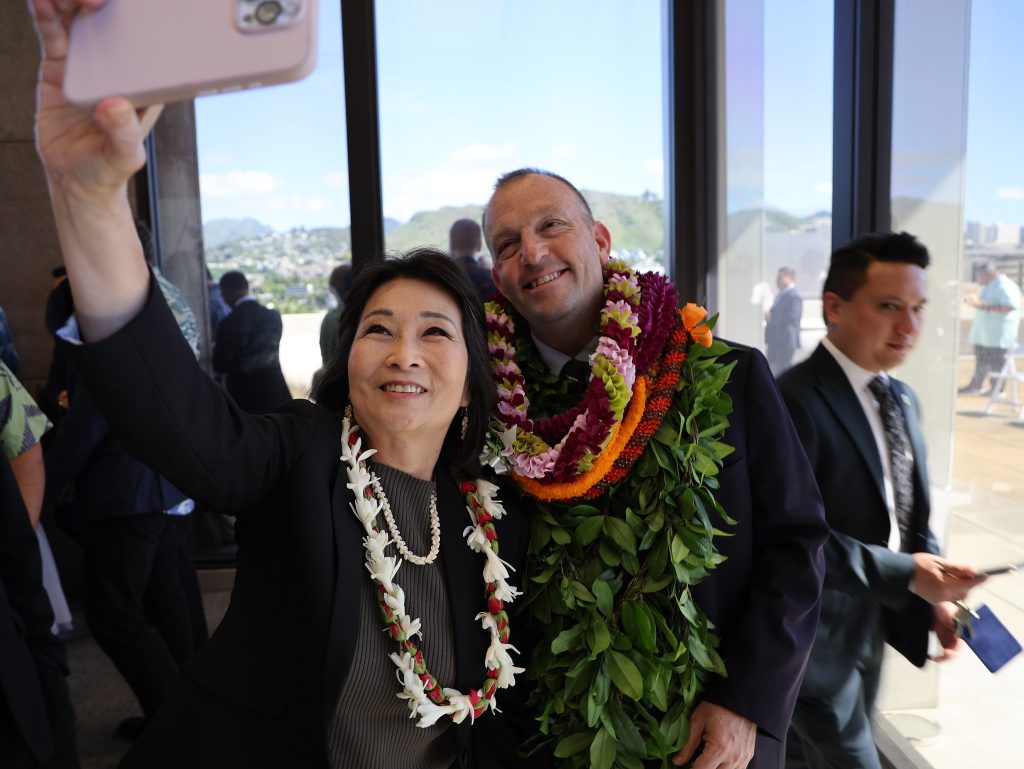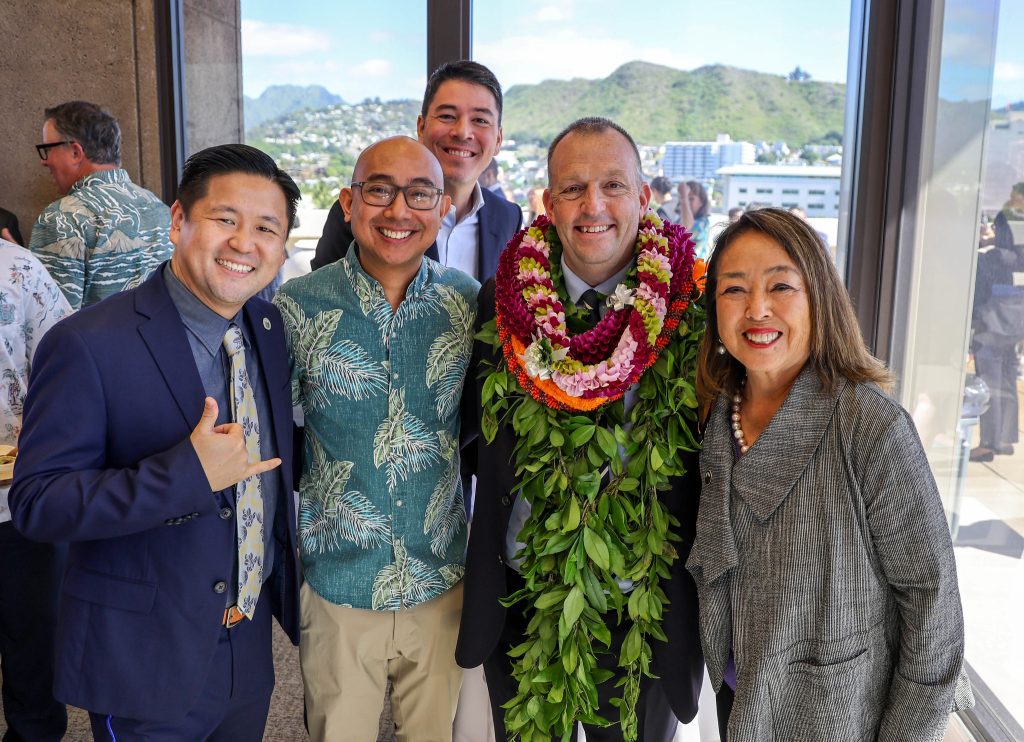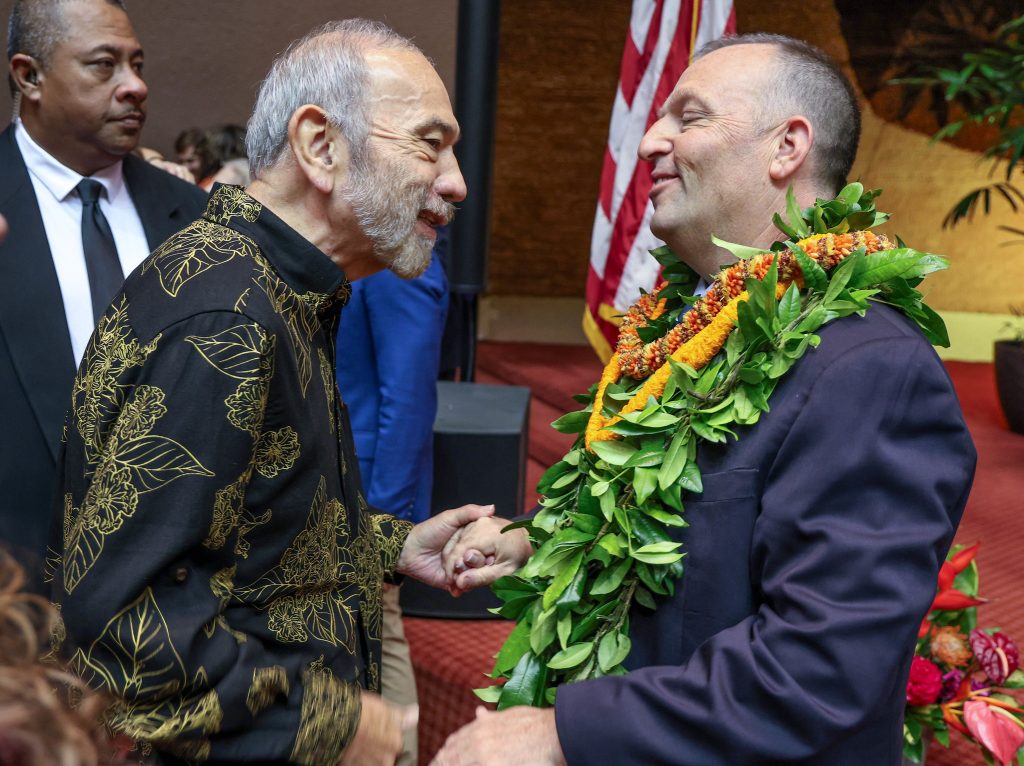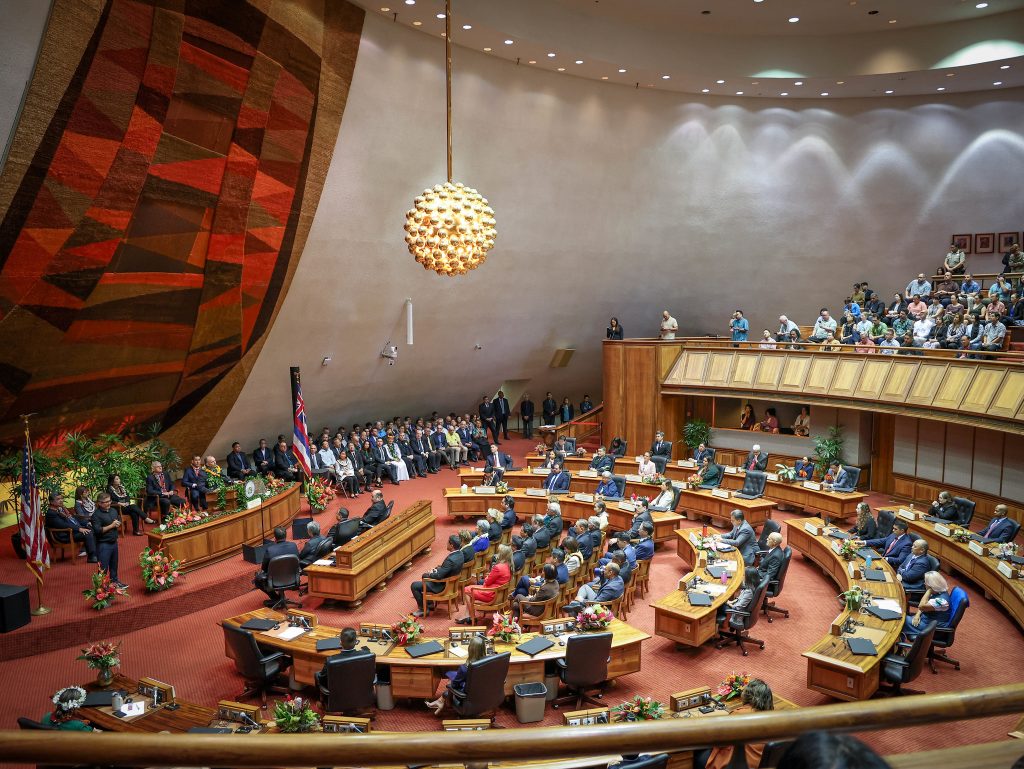Gov. Green addresses housing, high cost of living, Maui wildfire recovery

In his third State of the State address, Gov. Josh Green took aim this morning at Hawaiʻi’s high cost of living, affordable housing, accessible health care and Maui’s ongoing recovery from the August 2023 wildfires.
Progress has been made to help Maui recovery from the Aug. 8, 2023, wildfires that claimed the lives of at least 102 people and destroyed nearly 4,000 homes on Maui, exacerbating a statewide housing shortage of 50,000 units, he said.
“These fires — fueled by drought and fanned by hurricane force winds — were an unprecedented tragedy for Maui, and for our entire state,” Green told state legislators and dignitaries gathered for the governor’s annual address at the state Capitol. “Since that day, the people of Hawai‘i have united in showing care and support for the survivors and their families.”
Partnering with Mayor Richard Bissen’s county administration, the state has led a coalition of state, local and federal agencies in 17 months to clear debris from residential and commercial areas, restore infrastructure and build temporary and long-term housing and schools, the governor said.
“We have supported survivors with food, housing, medical and mental health services, and financial resources,” he said.
The $500 million Maui Interim Housing Plan was created to develop a pool of more than 3,000 housing units for displaced families, he said. The partnership included the Hawai‘i Community Foundation, the Council for Native Hawaiian Advancement and other philanthropists, he said.
Now, the state and its partners are building more than 1,200 temporary housing units for Maui wildfire survivors, he said, in addition to providing direct rental assistance aid for more than 5,600 displaced people.
Green also noted that the state and Maui County now have more than $2 billion in federal disaster relief funds to build housing and help Maui’s recovery.
“By leading the effort to reach a global legal and financial settlement, we averted the financial collapse of Maui County and Hawai‘i’s energy system, sparing our state years of economic hardship and higher energy costs,” he said.
Also, “last year, we began to build or built a total of 810 new units of permanent housing across four projects on Maui, and we are finishing 1,044 units of transitional housing to meet the community’s needs until we can fully rebuild Lahaina the way its people want it,” Green said.
More than 99% of people displaced by the Maui wildfires have been moved into long-term housing, Green said.
“As Maui continues to rebuild, I will do everything possible to ensure that we have the resources we need,” said.
In addition to the global settlement for Maui fire survivors, “we have requested over $350 million to continue investing in Maui’s recovery efforts, to fund schools, and to improve statewide wildfire prevention and disaster response,” he said.
Fire prevention improvements update and upgrade emergency siren protocols; re-establishing the State Fire Marshal (including a request for $2.2 million in funding; improving building and fire safety regulations, and guiding the state’s fire wildfire prevention and education efforts), he said.
Also, with the help of the federal government, the state is deploying 80 wildfire and 16 wind sensors throughout the state to provide an early-alert system with 24-hour sensing and alerting capabilities to identify changes in conditions before wildfires start, and to continuously transmit information and send electronic notifications when problems are detected, he said.
“The tragedy in Los Angeles validates the urgency of this effort,” he said.
Green said he has proposed that the state create defensible spaces around homes, develop mapped-out evacuation plans, and engage in community-wide preparedness initiatives to mitigate the impact of fires.
On Hawaiʻi’s high cost of living, Green said too many families struggle to make ends meet in the islands where residents struggle with the highest cost of living in the country.

“Too many people are forced to consider leaving the places they grew up in, and too many families have already left our state in search of a lower cost of living on the Mainland,” he said.
To make living in the islands more affordable, Green said his administration worked with the Legislature last year to double earned income and food tax credits, as well as increasing child and dependent tax credits, “saving Hawai‘i families about $88 million per year in taxes.”
The Legislature also passed, and Green signed into law, “the largest income tax cut for Hawai‘i families in our state’s history,” the governor said. “This tax cut will take effect in steps over the next seven years, providing an estimated $5.6 billion in total savings to our people.”
The tax cut is forecast to save 10% to 71% in taxes for working families, he said, “moving Hawai‘i from having the second-highest, to the fourth-lowest tax burden in the country.”
According to Green, a family of four making the median household income of $88,000 in Hawai‘i will see take-home pay increase by more than $3,600 by 2031 when the tax reform has been fully implemented.
The governor said state government spending was reduced by $500 million in 2024 and $1 billion in 2023 without cutting needed services and while maintaining $1.5 billion in the state’s rainy day fund.
Regarding the high cost of housing, the highest in the nation and the single largest expense for Hawai‘i families, Green said housing accounts for 38% of household spending on average .
“Our goal continues to be making our state more affordable, so local families can live in Hawai‘i and our next generation can have a future here — and in the coming years we will continue to find new ways to lower our cost of living,” he said.
Green said the state’s shortage of teachers and health care workers stem from a lack of affordable housing, and now more Native Hawaiians now live on the Mainland than in Hawai‘i.
Housing development has accelerated in the state over 18 months because Green instituted two emergency housing proclamations that have helped move ahead nearly 7,000 affordable homes statewide, he said.
Green also said his administration has worked with state lawmakers to deliver “the most significant housing regulatory and zoning reforms in over 40 years — cutting red tape, updating and improving rental laws, and increasing the affordable housing inventory statewide.”
The governor said his administration is tracking more than 62,000 housing units over 257 projects being built by state and county agencies and private developers over the next decade — with 13,000 new units to be completed this year and 10,000 more next year. Overall, projects are expected to produce 46,000 units of affordable housing, he said.
Green said he’s asking lawmakers to approve more than $500 million for housing initiatives, including $250 million for the Rental Housing Revolving Fund.
The governor noted progress with developing affordable housing on Department of Hawaiian Home Lands’s projects, including the first residential DHHL project on Maui in nearly two decades, the Puʻuhona Homestead project in Wailuku. When completed, that project will provide 137 turnkey homes and 24 improved lots, he said.
Green told lawmakers Hawai‘i has too many short-term rentals owned by individuals who live on the US Mainland.
“There are tens of thousands of housing units across the state that should not be short-term rentals; they should be homes for our people,” he said.
Green noted that, on average, the owner of a short-term rental makes four times more in income than if the property were rented out, long-term, to a local family. Fifty-two percent of short-term rentals in Hawai‘i are owned by people from out of state, with 27% owning 20 units or more.
Also, an estimated 75,000 of the 89,000 units in Hawai‘i’s short-term rental market are “not legal,” according to existing Hawai‘i laws, he said.
To take action last year, the Legislature passed and the governor signed into law Senate Bill 2919 that paved the way for reform of short-term rentals. Mayor Bissen wasted no time in proposing a phase-out of short-term rentals in apartment-zoned districts, a bill that is pending before the Maui County Council.
Green said the bill empowered the counties to reform short-term rentals, “returning thousands of housing units to the local market, increasing supply and bringing down prices.”
Regarding homelessness, Green said his administration has adopted the approach that “housing is healthcare,” to break a vicious cycle of homelessness and put people in inexpensive, tiny homes after being discharged from hospitals.
The cost to care a homeless person in Hawai‘i is an average of $82,000 per person per year — “and when they are discharged, they go right back on the streets where they get sick or injured again,” Green said.
“Instead of conducting sweeps that just move homeless people from one place to another without offering them help or hope, we saw an opportunity for a new approach that is both more compassionate, and more effective,” he said.
Green said he signed an Emergency Proclamation on Homelessness to “cut through the red tape that was preventing us from building more kauhale villages,” which are communal villages of tiny homes for homeless people with shared space for cooking, eating, recreation, growing food and community activities.
“Studies have shown that providing housing for chronically homeless individuals not only improves health outcomes but also saves taxpayers millions in health care costs,” he said.
A report by the University of Hawai‘i Center on the Family found that six months after these individuals were placed into permanent housing, their health care costs dropped by 76% to an average $1,965 per month, Green said.
Now there are 17 kauhale villages across the state, with a total of 30 villages to be completed by 2026, he said. Eventually, the villages will provide more than 1,500 housing units for the homeless.
Green asked lawmakers to approve his administration’s request for $10.8 million to support family assessment centers, the Housing First Program, the Rapid Re-housing Program, homeless outreach and civil legal services.
“With these innovations and investments, over the next five years we project a net savings of over $450 million for Hawai‘i taxpayers at the same time we are reducing homelessness and caring for those in need,” he said.
Green also asked for lawmakers to support efforts to make health care more accessible and affordable.
The Hawai‘i Physician Workforce Assessment Project’s December 2023 report estimated we have an unmet need of 757 physicians statewide, he said.
“To address our state’s shortage of health care professionals, we launched the Healthcare Education Loan Repayment Program, or HELP — a state-funded initiative to provide $30 million for educational loan repayment to more than 900 providers licensed or certified to practice in the state Hawai‘i,” he said.
Under the program, in exchange for a two-year commitment of service in Hawai‘i, health care professionals are eligible for loan repayments up to $50,000 per year — with 600 scholarships made available in the first year of the program, and another 600 in the second year.
HELP prioritizes primary care and behavioral health specialists with Hawai‘i ties, he said, and “we are placing extra emphasis on selecting mental health and addiction treatment professionals to address heightened concerns that have arisen from the COVID era and the Maui recovery.”
The Green administration has asked lawmakers to approve $30 million over the next two years to continue HELP, with support also coming from Salesforce co-founder Marc Benioff, who has pledged $10 million, $5 million last year and another $5 million in 2025 to support the program, the governor said.
On public safety, Green pledged to work with state lawmakers to prevent deadly fireworks accidents, such as the one that killed at least four people in the Salt Lake area of O‘ahu on New Year’s Eve.
“We’re going to have to make the collective decision to allow only safe and legal fireworks in our state going forward,” he said. “This year, I will also continue working with the Legislature to further curb illegal fireworks in our state so children and families in Hawai‘i can enjoy beautiful fireworks displays safely.”
He noted the establishment of an Illegal Fireworks Task Force, which has seized 227,000 pounds of illegal fireworks, and it is pursuing legislation to ensure that only safe and legal fireworks are used.
Also, two new gun safety laws have been passed, designating sensitive places where firearms are prohibited and providing active-shooter training in public and charter schools.
Two gun buyback events have been held, collecting approximately 1,000 firearms, he said. These include assault rifles, ghost guns and semi-automatic weapons — all removed from Hawai‘i’s streets.
For a full text of the governor’s State of the State address, click here.




















